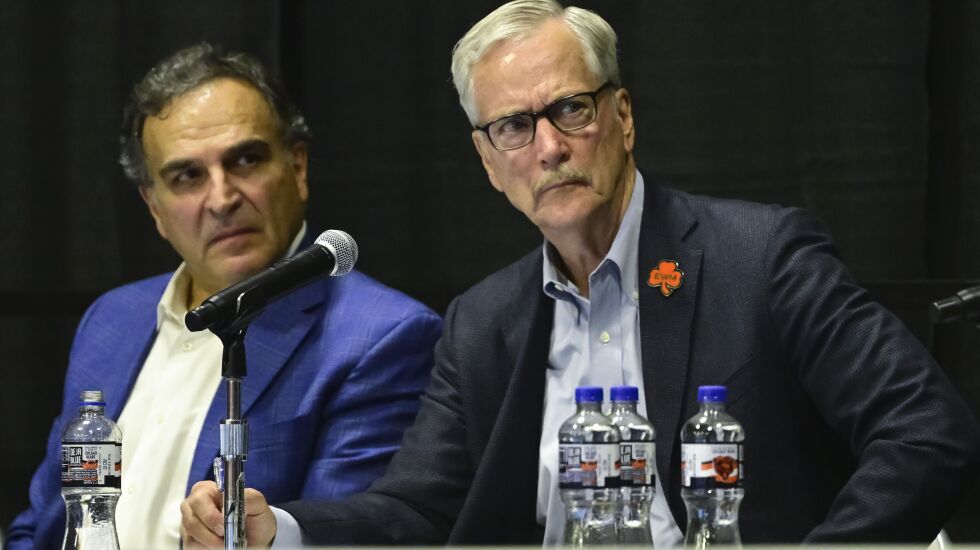
Many people in Arlington Heights seem to be excited about the prospect of the Bears building a stadium in their village and relocating from Chicago. The purported economic benefits and the big-league status that come with housing an NFL team are just two of the factors that stir the souls of the pro-stadium crowd.
The Bears held a community meeting in Arlington Heights a few weeks ago, and although words of dissent were heard, most in the audience seemed in favor of the team moving to their little slice of heaven. When team officials said that no tax dollars would be used to build the stadium itself, the general consensus wasn’t a resounding, “Go, Bears!’’ It was, “Come, Bears!’’
Now, I’m not here to ruin their buzz. These people like the idea of an NFL team playing on the former site of Arlington International Racecourse. Hooray for them. Good things do indeed follow a franchise’s move, though winning and an adequate quarterback aren’t necessarily among them. If they’re Bears fans, they already know this. And plenty of studies have shown that the positive economic impact of a new stadium are exaggerated.
But the Bears conveniently forgot two words when they declared no tax money would go into the building of a stadium in the northwest suburb: This time.
The lifespan of stadiums across the country is shrinking. In the NFL, it’s down to about 20 years, according to VenuesNow, a trade publication covering live entertainment venues. Whatever a stadium in Arlington Heights would look like on the day it opened, there’s a good chance it would look a lot different two decades later.
That’s what residents there need to know. When those good people applauded the Bears’ no-tax declaration, they likely were thinking of a stadium that would last a lot longer than 20 years. But there will be nothing to stop the Bears from coming to taxpayers in 2045 with their hand out. That could be for renovations like the $660 million rehab the team made to Soldier Field in 2003, paid for, in large part, by public funds.
Or it could be for a brand-new stadium. Wait, what? That’s crazy talk? You say the Bears’ proposed project is a multibillion-dollar palace that will age well like the Pyramids? Perhaps. More likely, though, is the distinct possibility that the new stadium would start to lag behind NFL standards soon after being built.
What drives owners to want new or renovated stadiums? New ways of making money. That could come from the “fan experience’’ in and around the building. It could come from innovations inside the stadium, from what the latest JumboTron can do to betting capabilities built into the seats. But while a stadium is being built, somebody is dreaming up other revenue streams that will make the latest version look Victorian in a few years.
No matter what the Bears are saying or implying, Arlington Heights residents need to understand that this is not a one-time issue. The Bears might be assuming the cost of construction of a new stadium this time. It doesn’t mean they’ll be in the same giving mood next time.
Bears chairman George McCaskey is drawn to the idea of the team being able to design its own stadium for the first time. The organization didn’t get the chance as renters at Wrigley Field and Soldier Field. But it’s worth noting that the team did design the renovations at Soldier Field, eventually found them to be lacking and now wants out. Things change, especially when there’s more money to be made.
The bonds on the renovated Soldier Field won’t be paid off until 2032, mostly through hotel taxes. When COVID-19 hit and hotel occupancy dropped drastically, Chicago taxpayers were on the hook for a $29 million shortfall. It’s a harsh lesson that life happens. It’s one that Arlington Heights taxpayers and officials need to consider. It’s also one that state and county residents should fear. They pay taxes, too.
If this sounds alarmist, you haven’t been paying attention to the stadium game. The Browns and Bengals built new stadiums around 2000. Two decades later, each is looking at rehabs costing about half a billion dollars apiece. The Atlanta Braves opened a new ballpark in 2017, 20 years after their previous home, Turner Field, opened. These examples are not the exception. They’re the rule. To list all the sports franchises planning stadium renovations or new stadiums, many of the projects at taxpayer expense, would take up most of this column.
The Bears understand that there’s little appetite for public money going toward a new stadium right now. There’s a good chance they won’t care about that the next time.
And there will be a next time.







